Physical Address
304 North Cardinal St.
Dorchester Center, MA 02124
The conjunctiva is a mucous membrane that covers the surface of the eyeball and posterior aspect of the eyelid that functions to protect the eye and allow the eyelids to move smoothly over the globe ( Fig. 27.1 ) . It is divided into four main regions: limbus, bulbar, fornix, and palpebral (tarsal) conjunctiva.
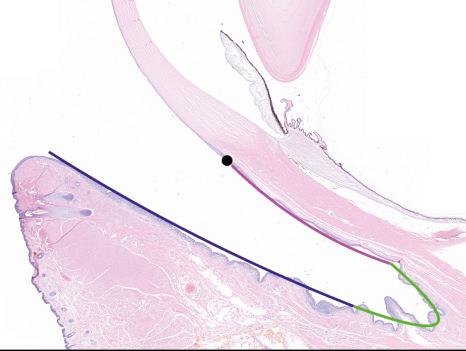
The limbus ( Fig. 27.2 ) is lined by nonkeratinizing stratified squamous epithelium, 8–10 cells thick, with stem cells in the basal layer. Melanocytes are present to protect stem cells from ultraviolet (UV) light damage. Darker-pigmented individuals are more heavily pigmented at the limbus compared with lighter-skinned individuals. The limbal basement membrane is wavy, with rete peg-like formations called the palisades of Vogt. The limbus is a common site of squamous and melanocytic neoplasms.
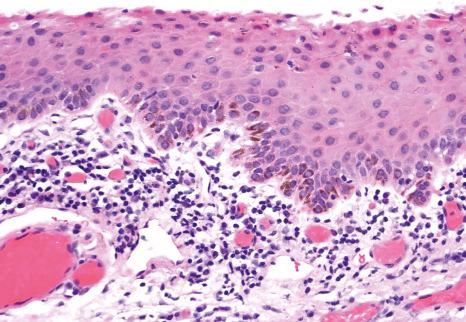
The bulbar conjunctiva is lined by nonkeratinizing stratified squamous epithelium with scattered goblet cells, mostly in the inferior and nasal portions ( Fig. 27.3 ). The connective tissue stroma, called the substantia propria, is loose in the bulbar conjunctiva.
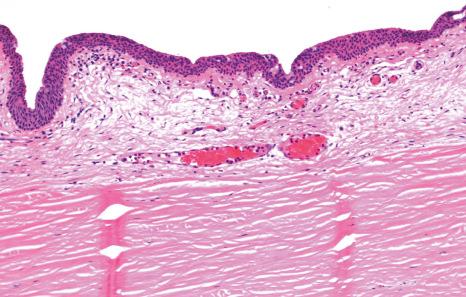
The fornix is lined by pseudostratified columnar epithelium with numerous goblet cells. The substantia propria is loose and contains lymphocytes and plasma cells that form the conjunctiva-associated lymphoid tissue (CALT) ( Fig. 27.4 ). Accessory lacrimal glands (glands of Krause) are also present.
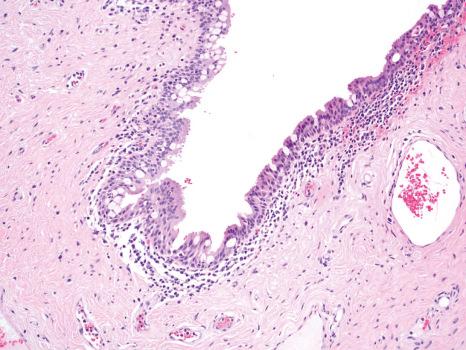
The palpebral or tarsal conjunctiva lines the posterior surface of the eyelid ( Fig. 27.5 ). It is lined by nonkeratinizing epithelium containing goblet cells. The substantial propria is very thin and tightly adherent to the tarsus. Accessory lacrimal glands (glands of Wolfring) are present at the superior aspect of the tarsus in the upper eyelid.
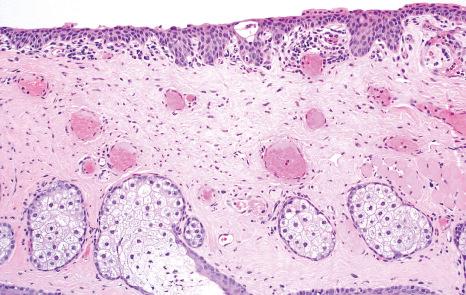
The conjunctival substantia propria contains numerous lymphatic vessels. Therefore, malignant neoplasms of the conjunctiva tend to spread to regional lymph nodes.
The caruncle is the fleshy tissue present in the medial interpalpebral angle of the eye. It is a specialized area of conjunctiva lined by nonkeratinized stratified squamous epithelium with hair follicles, smooth muscle, sebaceous glands, adipose tissue, accessory lacrimal glands, and sweat glands in the stroma. The plica semilunaris is another specialized portion of the conjunctiva just lateral to the caruncle with similar histologic features to other areas of the conjunctiva. Rarely, cartilage is present in the stroma.
Because the conjunctiva is readily visible, tumors and other lesions are usually recognized and diagnosed at a relatively early stage. An experienced ophthalmologist can often make an accurate diagnosis with careful external ocular examination and slit-lamp biomicroscopy. The bulbar, palpebral, and upper and lower forniceal conjunctiva, as well as the cornea, must be evaluated for tumor involvement, and lesions should be photographed to document the tumors and their margins. Corneal involvement by squamous or melanocytic neoplasia may be subtle, and appear as gray surface opacity.
Definitive diagnosis of conjunctival or corneal tumors requires histologic examination. Small (≤ 4 clock hours limbal tumor or ≤ 15 mm basal dimension), asymptomatic, benign appearing tumors are usually observed, and biopsied when there is evidence of growth or malignant change. For small tumors that are symptomatic or suspected to be malignant, complete removal (excisional biopsy) is recommended. For large lesions (> 4 clock hour limbal tumor or > 15 mm basal dimension), incisional biopsy is recommended because complete removal can severely compromise the ocular surface or may not be possible. Extensive conjunctival resection decreases the number of goblet cells, which interferes with corneal wetting. The resultant dry eye predisposes the patient to corneal ulceration and painful loss of vision. Incisional biopsy is also appropriate for tumors that are treated with radiotherapy, chemotherapy, or local means such as cryotherapy or topical chemotherapy, such as lymphoid tumors, metastatic tumors, and some cases of squamous cell carcinoma and primary acquired melanosis (PAM). Exfoliative cytology can be a helpful adjunct in select cases, but only provides information about superficial layers of the lesion and not the degree of invasiveness.
Tumors of the conjunctiva are generally classified by tissue or cell of origin, and whether the tumor is benign or malignant. Most conjunctival tumors are epithelial or melanocytic in origin. Hematopoietic tumors, such as lymphomas and leukemias, can occur in the conjunctiva. Other conjunctival tumors are from various elements of the conjunctival stroma, including vascular, fibrous, neural, histiocytic, myogenic, myxoid, and lipomatous. Other groups of conjunctival tumors include hamartomas and choristomas, caruncular tumors, metastatic and secondary tumors, and tumorlike lesions.
The classification of conjunctival tumors in this chapter is based on the second edition of the World Health Organization (WHO) International Histological Classification of Tumors with consultation of other major texts. The tumors discussed in this chapter are listed in Table 27.1 .
| Hamartomas and choristomas |
|
| Epithelial tumors |
| Benign epithelial tumors |
|
| Premalignant and malignant epithelial tumors |
|
| Melanocytic tumors |
| Benign melanocytic tumors |
|
| Premalignant and malignant melanocytic lesions |
|
| Benign and malignant stromal tumors |
| Vascular tumors |
|
| Fibrous tumors |
|
| Neural tumors |
|
| Histiocytic tumors |
|
| Myxoid tumors |
| Myxoma |
| Myogenic tumors |
| Rhabdomyosarcoma |
| Lipomatous tumors |
|
| Hematopoietic tumors |
|
| Metastatic and secondary tumors |
|
| Caruncular tumors |
|
| Lesions simulating conjunctival tumors |
|
Congenital lesions are usually hamartomas or choristomas, and diagnosed in infancy and childhood.
Epibulbar dermoid ( Fig. 27.6 ) is a congenital lesion that is most commonly located inferotemporally at the limbus. It is well circumscribed, tan-yellow, and may have fine hair protruding from the surface. The lesion may be isolated, or associated with Goldenhar syndrome (oculoauriculovertebral dysplasia). Patients should be evaluated for preauricular skin appendages, hearing loss, eyelid colobomas, mandibular hypoplasia, and vertebral abnormalities. Dermoid can cause astigmatism and amblyopia.
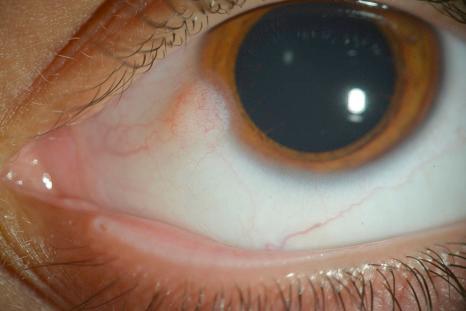
Epibulbar dermoid is composed of dense fibrous tissue containing dermal appendages, such as hair follicles, sebaceous glands, sweat glands, and sometimes adipose tissue, lined by nonkeratinizing stratified squamous epithelium ( Fig. 27.7 ).
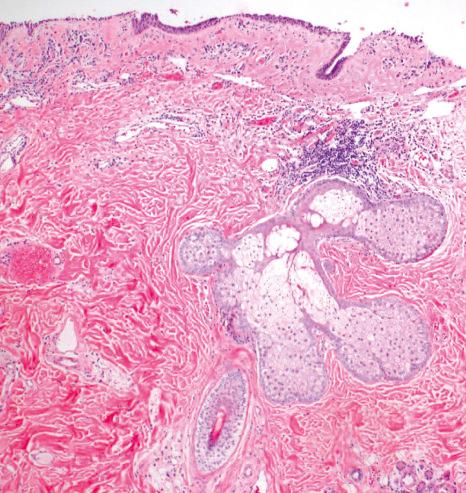
Dermolipoma is a congenital lesion, most commonly located superotemporally in the fornix. Patients may be asymptomatic for years, and present in adulthood with a mass that appears soft and yellow with fine hairs on the surface. The lesion may extend into the orbit and onto the bulbar conjunctiva.
Dermolipoma is composed of variable amounts of fibrous connective tissue and adipose tissue, lined by conjunctival epithelium. Pilosebaceous units and lacrimal gland tissue may be present. Dermolipoma may be associated with Goldenhar syndrome.
Osseous choristoma is a rare congenital lesion that presents as an epibulbar mass superotemporally, usually in early infancy or childhood. The lesion may be adherent to the extraocular muscle sheath, overlying conjunctiva, or underlying sclera.
Osseous choristoma is composed of mature cortical bone surrounded by fibrous connective tissue ( Fig. 27.8 ).
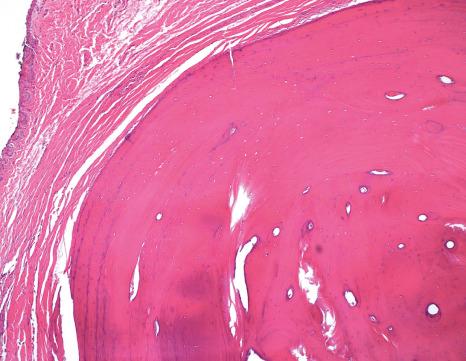
Lacrimal gland choristoma is a congenital lesion that presents as an asymptomatic, pink stromal mass superotemporally or temporally in young children. It has also been described in the limbal area. Rarely, the lesion may be cystic.
Lacrimal gland tissue is present in the conjunctival stroma.
Complex choristoma contains tissue derived from two germ layers. The clinical appearance depends on the components of the lesion: for example, a tumor with lacrimal gland tissue may appear pink; one with dermal tissue may appear yellow-white, and one with cartilage, smooth and blue-gray. Complex choristoma may be associated with nevus sebaceous of Jadassohn. Patients should be evaluated for nevus sebaceous of the face, as well as neurological features, such as seizures, mental retardation, arachnoid cyst, and cerebral atrophy.
Complex choristomas may include a combination of ectopic tissues, including dermal tissue with adipose tissue and dermal appendages, lacrimal gland tissue, smooth muscle, cartilage, and bone ( Figs 27.9 and 27.10 ).
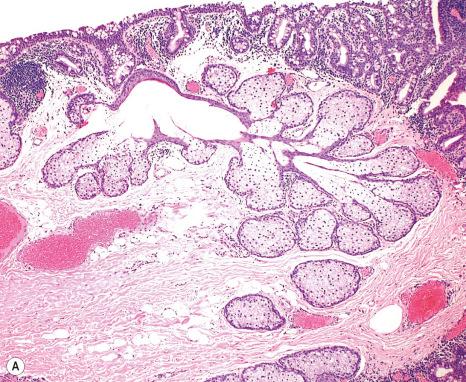
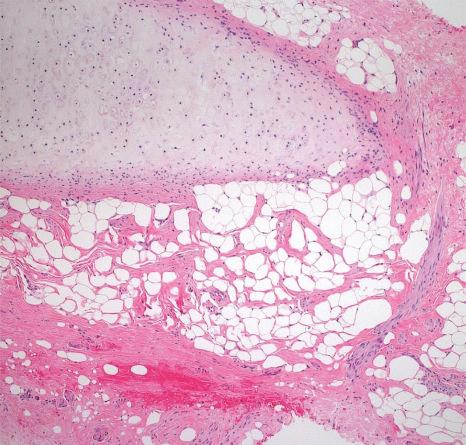
Epithelial tumors are located on the surface of the conjunctiva. They generally have irregular, granular, or papillary surfaces and may be leukoplakic or gelatinous in appearance. Epithelial tumors can be superficial and thin, or thick and fleshy. In this section, we will discuss a number of benign epithelial tumors, including more common entities (e.g., squamous papilloma and epithelial cyst) and rare entities (e.g., keratoacanthoma, hereditary benign intraepithelial dyskeratosis [HBID], dacryoadenoma, oncocytoma, keratotic plaque, and actinic keratosis), as well as premalignant and malignant epithelial tumors (i.e., ocular surface squamous neoplasia [OSSN], which includes squamous cell carcinoma).
Squamous papilloma is a common benign tumor, comprising 14.5% of epithelial lesions excised from the conjunctival sac and 13% to 32% of all tumors of the caruncle. It is a pink to red fleshy lesion with finger-like projections that may be pedunculated or sessile ( Fig. 27.11 ). Those arising at the lid margin or caruncle tend to be pedunculated, whereas those arising at the limbus are usually sessile. The growth pattern may be exophytic, mixed exo- and endophytic, or rarely, endophytic (inverted). It is more common in males than females, and can occur in children and adults (mean age, 39.6 years; range, 17–84). Lesions may be single or multiple, and most commonly arise medially and inferiorly. Squamous papilloma is associated with human papillomavirus (HPV), usually types 6 and 11. Lesions may recur, and rarely progress to carcinoma. Inverted papilloma is rare, with 10 reported cases in the literature since it was described in 1979, and has more benign, less aggressive behavior compared with its sinonasal counterparts.
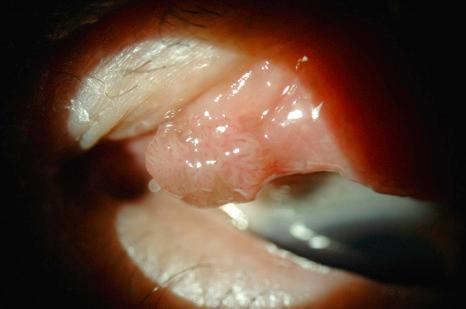
Squamous papilloma has a frondlike growth pattern with fibrovascular cores ( Fig. 27.12 ). Given the association with HPV, koilocytosis and occasionally, varying degrees of dysplasia, typically low-grade, may be seen. In one study, 40% of squamous papillomas had some degree of inflammation.
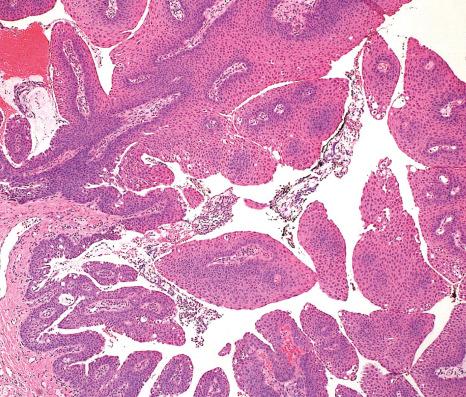
Inverted papilloma is an epithelial proliferation surrounding fibrovascular cores with an endophytic growth pattern. Goblet cells or cysts are typically identified within the tumor; hence, Jakobiec and colleagues suggested the term ‘inverted mucoepidermoid papilloma’ to reflect these features. Inverted papilloma may be misdiagnosed histologically as squamous cell carcinoma. Features distinguishing inverted papilloma from squamous cell carcinoma include: well-defined, circumscribed margins; blending of the lesion with surface epithelium that is not dysplastic; no sharp demarcation between proliferating epithelium and normal surface epithelium; no obvious cytological atypia or conspicuous mitotic figures; absence of prominent perilesional inflammatory infiltrate; presence of multiple cysts with goblet cells; and presence of eosinophilic globoid cytoplasmic inclusions that represent inspissated mucus. Additionally, HPV is usually negative in inverted papilloma, and p53 and Ki67 are usually low (10–20% compared with > 50% in dysplasia and carcinoma for p53; < 1% compared with > 25% in dysplasia and carcinoma for Ki67) by immunohistochemistry.
Reactive epithelial hyperplasia (pseudoepitheliomatous hyperplasia, pseudocarcinomatous hyperplasia) occurs secondary to irritation caused by concurrent or pre-existing stromal inflammation. It presents as an elevated, leukoplakic pink lesion that usually occurs in the limbic area. Histologically, it shows acanthosis, hyperkeratosis, or parakeratosis and subepithelial inflammation. Mitotic figures may be present, but cytological atypia is generally absent. Clinically and histologically, reactive epithelial hyperplasia may be difficult to differentiate from conjunctival squamous cell carcinoma. An infiltrative growth pattern, marked cytological atypia, and excessive mitotic activity (including atypical forms) obviously favor the latter diagnosis.
Keratoacanthoma is a rare lesion with fewer than 20 reported cases that grows rapidly, over a period of 3 to 4 weeks. It most frequently occurs at the temporal limbus. The lesion is a white nodular mass with a hyperkeratotic area and surrounded by dilated blood vessels, and may be clinically indistinguishable from squamous cell carcinoma.
Keratoacanthoma of the conjunctiva shows similar features to that of the skin, with crateriform architecture filled with keratin. The surrounding epithelium is acanthotic and hyperkeratotic with focal parakeratosis and dyskeratosis. A chronic inflammatory infiltrate is often present at the base. Cytological atypia is usually mild, but some cases may demonstrate marked atypia, causing difficulty in distinguishing from well-differentiated squamous cell carcinoma.
HBID is a rare, autosomal dominant condition that presents at birth or early childhood, characterized by elevated plaques on the nasal or temporal bulbar conjunctiva and oral mucosa. The majority of patients trace their ancestry to the Haliwa-Saponi Native American tribe in North Carolina. Some patients are Caucasian French. Lesions may involve the cornea and be associated with hyperemia and foreign body sensation. Using genetic linkage analysis, the gene for HBID in Native Americans was located to chromosome 4 (4q35). In a group of Caucasian French patients, next-generation sequencing identified a novel missense mutation in the NLRP1 gene on chromosome 17 (17p13.2).
Histopathology shows acanthotic epithelium with hyperkeratosis and dyskeratosis. Chronic inflammation is present at the base. There is no invasion of underlying tissue. Exfoliative cytology may be a useful alternative for patients who are suspected to have HBID, but are unable to undergo biopsy. Cytological features include rounded squamous epithelial cells with dense homogenous orange cytoplasm and hyperchromatic oval or crenated nuclei, occasionally accompanied by small lymphocytes.
Dacryoadenoma is a rare, benign conjunctival tumor that appears as a pink mass. Histologically, dacryoadenoma is a proliferation of metaplastic surface epithelium that forms tubular and glandular structures similar to the lacrimal gland. Myoepithelial cells are associated with the acinar-type epithelium, and goblet cells are also present.
Oncocytoma is a benign tumor that usually arises in the caruncle of older, female patients ( Fig. 27.13 ). Patients typically present with a fleshy, subepithelial, orange-red or dark blue mass, often with intralesional cysts. Ultrasound biomicroscopy may show mixed solid and cystic components. Oncocytoma may also arise from lacrimal sac, lacrimal gland, or eyelid.
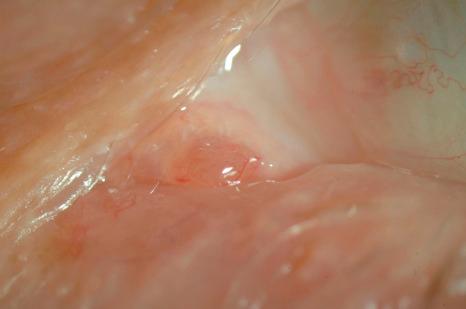
Oncocytoma is a circumscribed nodule of epithelial cells with abundant, granular eosinophilic cytoplasm arranged in nests, cords, or sheets that may form glandular or ductal structures ( Fig. 27.14 ). Carcinomatous transformation is very rare.
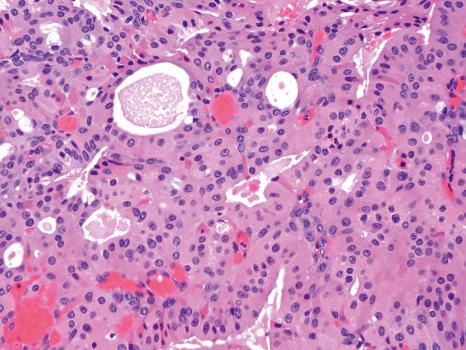
Conjunctival cysts are common lesions that may be congenital or most often, acquired. They may occur spontaneously, or after surgical or nonsurgical trauma. Acquired cysts are mostly implantation (epithelial inclusion) cysts of surface epithelium. Ductal cysts, which arise from accessory lacrimal glands, are also common. Cysts appear smooth and translucent, and contain clear fluid ( Fig. 27.15 ).
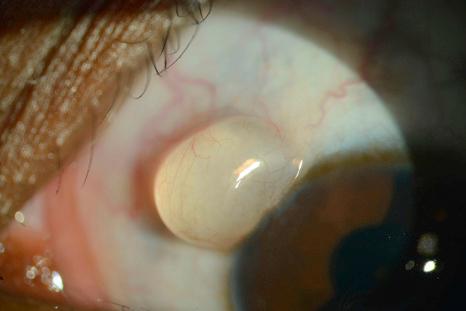
Epithelial inclusion cysts are lined by conjunctival epithelium and contain clear fluid. Ductal cysts are lined by a double layer and contain periodic acid-Schiff (PAS)-positive material ( Fig. 27.16 ).
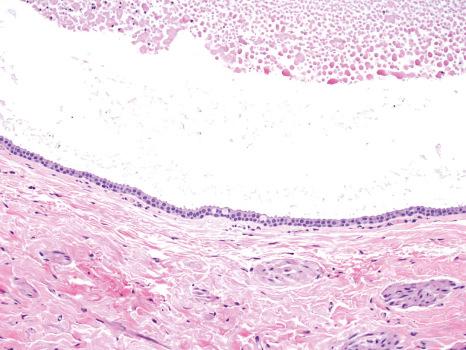
Keratotic plaque and actinic keratosis are clinically indistinguishable and manifest as a flat, white plaque on the interpalpebral bulbar conjunctiva or limbus. Keratotic plaque has little to no malignant potential, whereas actinic keratosis is a precancerous lesion.
Keratotic plaque is composed of acanthotic epithelium with keratinization and parakeratosis. Actinic keratosis is similar, and often occurs over a chronically inflamed pinguecula or pterygium. There is variable cytological atypia that ranges from minimal to severe ( Fig. 27.17 ).
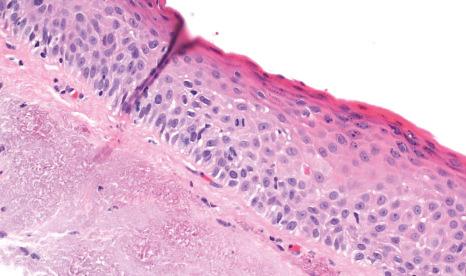
OSSN encompasses a spectrum of conjunctival and corneal tumors ranging from low-grade dysplasia to carcinoma in situ and invasive squamous cell carcinoma. Noninvasive squamous epithelial neoplasms (i.e., mild dysplasia, moderate dysplasia, severe dysplasia, and carcinoma in situ) are referred to as conjunctival intraepithelial neoplasia (CIN).
OSSN occurs worldwide. The incidence of squamous cell carcinoma varies based on geographic location with more than 12 cases per million per year in Uganda, 1.4 per million per year in Western Australia, 0.3 per million per year in the United States, and less than 0.2 per million per year in the United Kingdom. Newton et al. found that the incidence of squamous cell carcinoma decreased by 49% for each 10° increase in latitude, which is related to the degree of UV sunlight exposure.
OSSN usually occurs in older men in temperate climates, but both sexes are affected equally in Africa. The difference is thought to be due to increased prevalence of human immunodeficiency virus (HIV) infection in the African population. In one study of 101 eyes from the United States, the median age was 71 years (range, 37–96 years) and 67% of patients were male. In developed countries, it is thought that older men are at higher risk for OSSN because of greater cumulative UV light exposure.
Solar UV light, particularly UVB rays, is a major risk factor. Lesions are usually located within the interpalpebral fissure, arising from the limbus, particularly in the nasal quadrant. The nasal aspect of the limbus is particularly vulnerable because direct sunlight received at the temporal aspect of the limbus is focused nasally, where the limbal basal cells contain less melanin. Other risk factors include human HPV and HIV infection. High-risk HPV types promote oncogenesis through inactivation of Rb and p53. HPV-16 has been detected in conjunctival dysplasia and carcinoma. However, one study showed no statistically significant association between the presence of anti-HPV antibody and risk of conjunctival squamous neoplasia, suggesting that HPV alone may be insufficient to cause OSSN. Patients affected by HIV have an 8-fold increased risk of developing OSSN. Possible mechanisms that HIV contributes to tumorigenesis include weakened tumor surveillance, potentiation of oncogenic viruses such as HPV, and inducing a state of persistent inflammation. Not surprisingly, tumors that develop in HIV-positive patients are generally larger, higher grade, and more likely to recur.
Clinically, CIN appears as a sharply demarcated, fleshy, sessile, or elevated lesion, most commonly at the limbus, where the stem cells are located, with conjunctival and/or corneal involvement ( Figs 27.18–27.20 ). The lesion may appear gelatinous, leukoplakic, or papilliform. Invasive squamous cell carcinoma ( Fig. 27.21 ) is generally larger and more elevated than CIN, but it may be difficult to distinguish one from the other. It is gray-white and exophytic, usually surrounded by inflamed conjunctiva. Rarely, tumors may demonstrate a diffuse growth pattern that mimics chronic conjunctivitis.
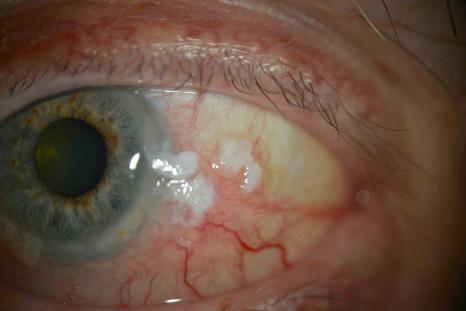
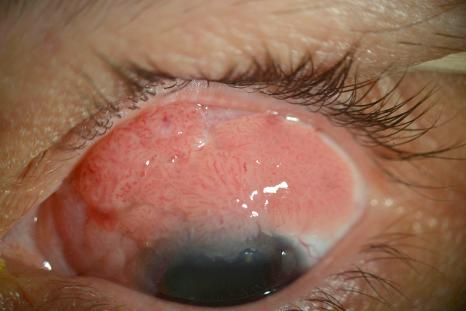
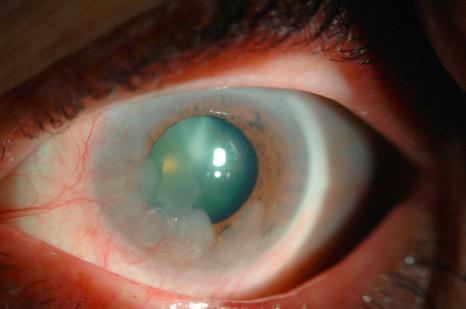

OSSN is considered a low-grade malignancy. Lesions are usually confined to the ocular surface, but can recur and infrequently metastasize. Reported recurrence rates are 17% to 24% for dysplasia and 30% to 41% for squamous cell carcinoma. Most recurrences are confined to the ocular surface, and can be treated locally or with excision. This is thought to be due to the difficulty in determining tumor edges and margins. Factors associated with higher risk of recurrence in OSSN include a higher T category, particularly T3 (tumor invades adjacent structures, excluding orbit) and T4 (tumor invades orbit with or without further extension) using the American Joint Committee on Cancer – TNM (AJCC-TNM) staging system ( Table 27.2 ). T category is also an important prognostic indicator of poor outcome. Larger tumor size of at least 2 cm and diffuse growth pattern also increase the risk of recurrent disease.
| Pathological and clinical staging | |
| Primary tumor (T) | |
| TX | Primary tumor cannot be assessed |
| T0 | No evidence of primary tumor |
| Tis | Carcinoma in situ |
| T1 | Tumor ≤ 5 mm greatest dimension |
| T2 | Tumor > 5 mm great dimension, without invasion of adjacent structures |
| T3 | Tumor invades adjacent structures, excluding orbit |
| T4 | Tumor invades orbit with or without further extension |
| T4a | Tumor invades orbital soft tissues without bone invasion |
| T4b | Tumor invades bone |
| T4c | Tumor invades adjacent paranasal sinuses |
| T4d | Tumor invades brain |
| Regional lymph nodes (N) | |
| NX | Regional lymph nodes cannot be assessed |
| N0 | No regional lymph node metastasis |
| N1 | Regional lymph node metastasis |
| Distant metastasis (M) | |
| MX | Distant metastasis cannot be assessed |
| M0 | No distant metastasis |
| M1 | Distant metastasis |
Intraocular invasion is rare, but can occur in older patients who had multiple excisions for one or more recurrences of squamous cell carcinoma near the limbus. Tumors can also invade into the orbit. Metastatic conjunctival squamous cell carcinoma is extremely rare, occurring in advanced neglected cases.
Definitive diagnosis is based on histopathological examination of a biopsy. However, other approaches have been explored, such as vital staining, exfoliative cytology, impression cytology, and high-frequency ultrasonography. In some studies, topical application of methylene blue and 1% toluidine blue had a high sensitivity for the detection of OSSN when performed with clinical examination. Exfoliative cytology and impression cytology may be helpful adjuncts for diagnosis of OSSN, especially in patients who refuse biopsy. By impression cytology, cellular features of OSSN include keratinized dysplastic cells often accompanied by hyperkeratosis, syncytial-like groupings, and nonkeratinized dysplastic cells. Invasive squamous cell carcinomas may show significant keratinization and greater degree of inflammation, or little evidence of keratinization and presence of one or more macronucleoli. However, because considerable overlap exists between intraepithelial and invasive squamous lesions, cytological methods do not reliably distinguish intraepithelial disease from invasive lesions. High-frequency ultrasonography may be helpful to assess the extent of OSSN for local invasion prior to surgery.
Dysplastic lesions (CIN) are classified as mild, moderate, or severe dysplasia based on the extent of epithelial involvement. Dysplastic changes originate in the basal layers and extend toward the surface, with mild, moderate, and severe dysplasia involving the lower one-third, up to two-thirds, and greater than two-thirds of the epithelial thickness, respectively. Mitotic figures are frequent and may be atypical. The involved epithelium is thickened and sharply demarcated from the adjacent normal-appearing conjunctival epithelium. Some lesions may have fronds of proliferating blood vessels and connective tissues, mimicking sessile papilloma.
Carcinoma in situ shows total loss of normal cellular maturation with cytological atypia ( Figs 27.22 and 27.23 ). Surface keratinization may be present, and mitotic figures can be seen in all layers of the epithelium. Invasive squamous cell carcinoma has similar cytological features to carcinoma in situ, but has invaded through the basement membrane into the conjunctival substantia propria. It is characterized by lobules, nests, and cords of atypical squamous cells with individual cell dyskeratosis and variable degrees of keratinization ( Figs 27.24 and 27.25 ). Mitotic activity is usually low, and atypical mitotic figures may be seen. Ohara and colleagues, using immunohistochemistry for Ki-67 proliferation index, showed that dysplasia (CIN) and squamous cell carcinoma have significantly higher proliferation compared with normal. Additionally, sebaceous gland carcinoma, an important differential diagnosis, has a significantly higher proliferation index compared with squamous cell carcinoma. Immunohistochemical stains for adipophilin and androgen receptor may also be helpful in differentiating sebaceous gland carcinoma from squamous cell carcinoma. In darkly pigmented patients, OSSN may be pigmented because of abnormal proliferation of melanocytes, simulating melanoma. OSSN of the cornea typically occurs as extension of a limbal lesion; isolated corneal involvement is rare.
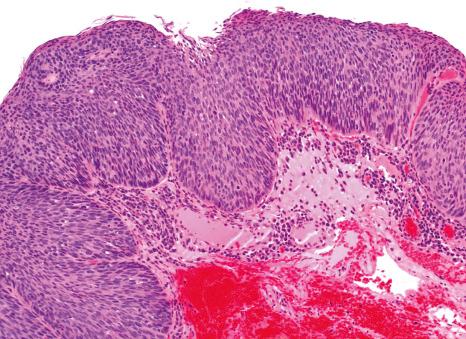
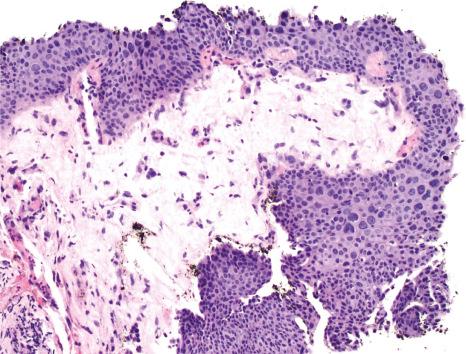
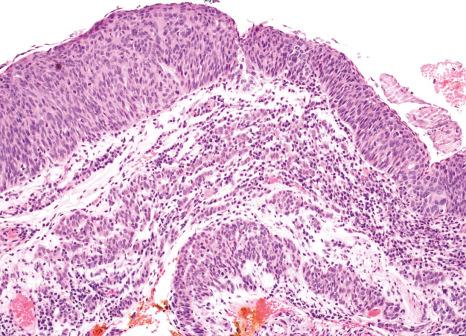
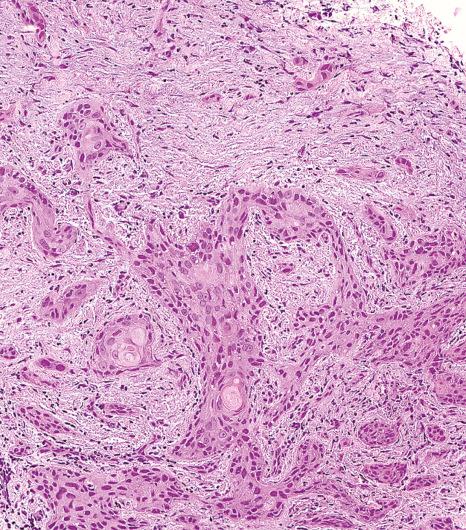
Three variants of squamous cell carcinoma deserve special mention because of more aggressive biological behavior compared to conventional squamous cell carcinoma. These variants may invade the eyeball or orbital tissue or metastasize. Mucoepidermoid carcinoma is composed of an admixture of epidermoid cells, intermediate cells, and mucous-producing cells that stain positively with special stains for mucopolysaccharides. Spindle cell carcinoma is composed of infiltrating spindled cells with oval vesicular nuclei, and large nucleoli. The overlying epithelium is acanthotic with variable degrees of dysplasia. By immunohistochemistry, spindle cells are immunoreactive to keratin. Adenoid squamous carcinoma has foci of pseudoglandular spaces due to acantholysis of neoplastic squamous cells. Extracellular hyaluronic acid is present, and intracellular mucin is absent.
Most pigmented conjunctival lesions are derived from melanocytes. In this section, we will discuss conjunctival nevus, a common conjunctival tumor, as well as complexion-associated melanosis, PAM, a potential precursor of melanoma, and malignant melanoma. Other causes of conjunctival pigmentation should be considered in the differential diagnosis, including aggregation of melanophages in the substantia propria; some systemic diseases, such as Addison disease or ochronosis; use of certain medications, such as tetracycline or topic epinephrine; or deposition of metals, such as silver (argyrosis).
Conjunctival nevus is the most common melanocytic tumor of the conjunctiva, comprising 23% to 29% of conjunctival tumors in several large series. Conjunctival nevi may be divided into congenital (appearing within the first 6 months of life) or acquired (appearing more than 6 months after birth) types.
In one large series of 410 conjunctival nevi, the mean age is 32 years with a wide range of 2–93 years. The majority of patients are Caucasian, and there is equal sex predilection. Most lesions are located on the bulbar conjunctiva (72%) ( Figs 27.26–27.28 ), caruncle (15%), or plica semilunaris (11%). Nevi are rarely found in the fornix, tarsal conjunctiva, or within the cornea; therefore, pigmented lesions in these areas should raise suspicion for PAM or melanoma. Conjunctival nevus most commonly develops near the limbus. The most common clinical presentation is the appearance of a spot on the eye. Pain is very rare.
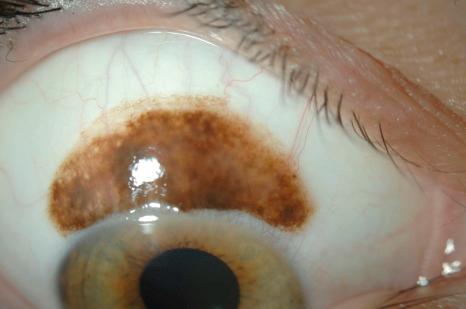
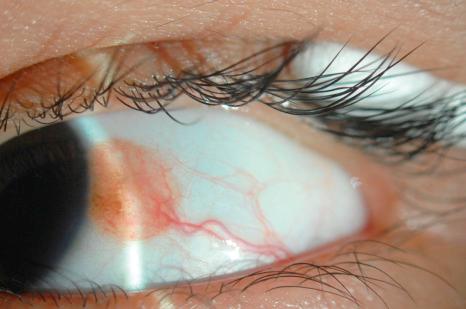
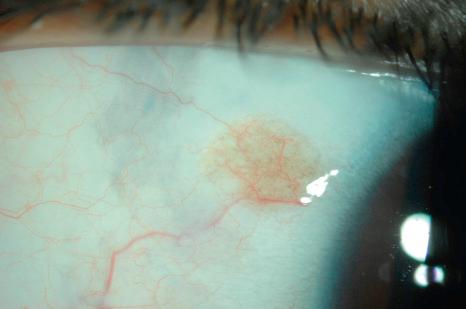
Clinically, the tumor is most commonly brown, and less often tan or nonpigmented. Intralesional cysts are present in the majority of lesions. Feeder vessels and intrinsic vessels, which may be prominent in conjunctival melanoma, can be seen in approximately one-third of cases.
Histologically, conjunctival nevi are described as junctional, compound, or subepithelial, which may be considered as stages of evolution. Junctional nevi are found only early in life and have nests of nevus cells along the interface of the epithelium and substantia propria. Junctional nevus cells generally have abundant cytoplasm. As intraepithelial nevus cells begin dropping off into the substantia propria, dragging surface epithelium with them, nevus cells and intraepithelial inclusions expand the substantia propria. The nevus becomes thicker clinically. A nevus with cells in the epithelium and substantia propria is a compound nevus ( Fig. 27.29 ). The intraepithelial component of a compound nevus should not extend much beyond the lateral edges of the subepithelial component. The presence of melanocytes individually or in nests far beyond the lateral margins of the subepithelial component should raise suspicion for intraepithelial atypical melanocytic hyperplasia, also known as PAM with atypia, which is a precursor lesion for melanoma. Over time, the nevus may become disconnected from the overlying epithelium and reside completely in the substantia propria. This type of nevus is designated as subepithelial nevus ( Fig. 27.30 ) and is analogous to intradermal nevus of the skin. Compared with intraepithelial nevus cells, those in the substantia propria generally have less cytoplasm, especially toward the base, which reflects maturation. Some nevus cells may contain intranuclear cytoplasmic inclusions. Binucleated and multinucleated cells may be identified, and are not indicative of malignancy. Two distinct types of nevus cells, balloon cells and spindle cells, can be seen in otherwise typical conjunctival nevi. Balloon cell nevi have rarely been reported. Occasionally, conjunctival combined nevi are encountered.
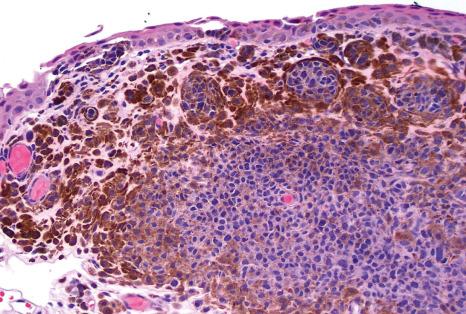
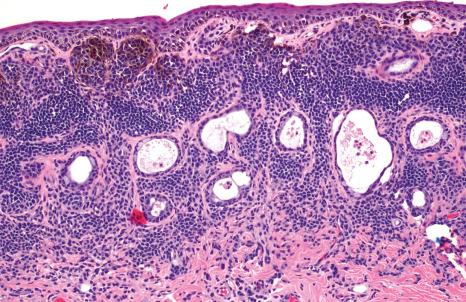
Conjunctival Spitz nevus is a very rare melanocytic lesion that usually occurs in children and adolescents. The lesion is nonpigmented and grows rapidly, raising suspicion for melanoma, although melanoma is extremely uncommon in children.
In contrast to typical conjunctival nevus, which may contain spindle cells within the epithelium that are oriented parallel to the surface, Spitz nevus is composed of fascicles of spindle nevus cells that are usually oriented perpendicular to the surface and are uniformly and symmetrically arranged. Mitotic figures or brisk expression of MIB-1 in Spitz nevi reflect rapid clinical growth and do not indicate malignancy.
Conjunctival blue and cellular blue nevi are rare lesions that arise from neural crest cells that do not reach the epithelial surface during embryonic migration. Clinically, the lesion is sharply demarcated and appears brown or black. Lesions may be unifocal or multifocal and occur at any site of the conjunctiva. There is only one reported case of malignant melanoma arising from blue nevus.
Conjunctival blue nevus is composed of uniformly pigmented spindle-shaped cells in the substantia propria. Dendritic melanocytes are also present. Cellular blue nevus has lightly pigmented nodules of uniform spindle cells surrounded by heavily pigmented dendritic melanocytes. When elements of blue nevus are present with a common acquired or congenital nevus of the conjunctiva, it is termed combined nevus ( Fig. 27.31 ).
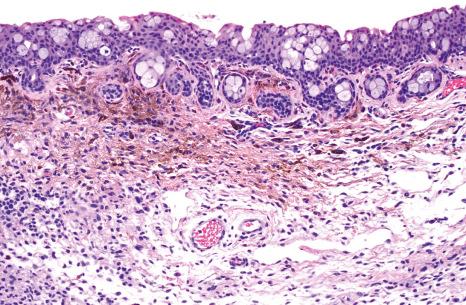
Inflamed juvenile conjunctival nevus is a benign, usually amelanotic, juxtalimbal lesion in children and adolescents ( Fig. 27.32 ). It may grow rapidly, raising concern for malignancy. Patients often have history of allergy, allergic conjunctivitis, or vernal conjunctivitis. This association is supported by one study that showed increased expression of nerve growth factor, eosinophils, and mast cells in inflamed juvenile nevus and modulation of eosinophil properties by lesional fibroblasts, partly through nerve growth factor. Intralesional cysts may be seen clinically.
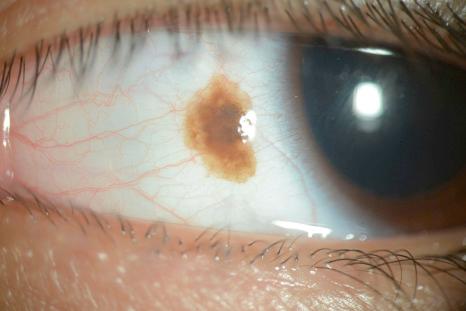
Inflamed juvenile conjunctival nevi have intraepithelial and stromal melanocytic nests with solid and cystic inclusions, goblet cells, and chronic inflammatory infiltrates with eosinophils and plasma cells ( Fig. 27.33 ). Rapid growth of a clinically inflamed nevus indicates inflammatory infiltration and cystic enlargement rather than malignant transformation.

Congenital melanosis oculi or congenital ocular melanocytosis is characterized by flat, spiculated slate-gray pigmentation of the sclera sometimes surrounding episcleral lymphatics and blood vessels ( Fig. 27.34 ). The periocular skin, orbit, meninges, and soft palate may be affected. Although the conjunctiva is not involved, the lesion is included here because it is considered in the clinical differential diagnosis of conjunctival pigmented lesions. When periocular skin is involved, the condition is called nevus of Ota or oculodermal melanocytosis. Patients with congenital melanosis oculi have approximately 1 in 400 risk of developing uveal melanoma; however, conjunctival melanoma has not been described in these patients.
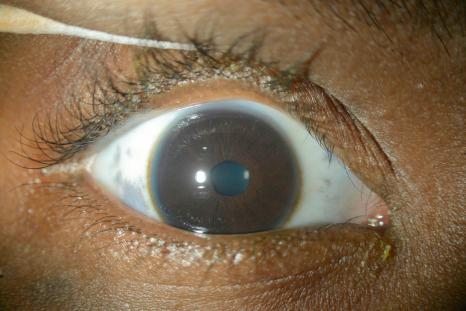
Pigmented dendritic melanocytes are present in the episcleral and scleral tissues ( Fig. 27.35 ). The conjunctiva is not involved.
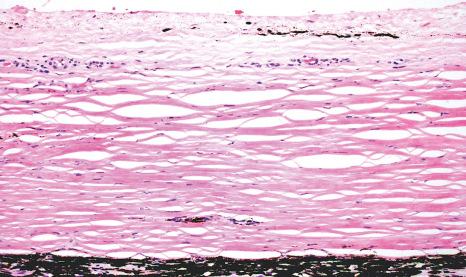
Complexion-associated melanosis is a common, bilateral condition characterized by diffuse or patchy, flat pigmentation of the conjunctiva in patients with dark skin complexion, including African-Americans, Hispanics, Asians, and whites. The pigmentation is concentrated around the limbus and may involve the cornea. It rarely involves the fornix or palpebral conjunctiva. The distribution of pigmentation may be asymmetric, but this should raise suspicion for PAM, a unilateral, potentially premalignant condition (see next section).
Histologically, there is hyperpigmentation of basal conjunctiva squamous epithelial cells without melanocytic hyperplasia or cytological atypia.
PAM is a clinical term used to describe localized or diffuse flat pigmentation of the conjunctiva. Lesions are primary because they cannot be attributed to a known cause, such as Addison disease. Lesions are acquired rather than congenital, as they usually occur in middle-aged or older individuals rather than in children, and occur in the conjunctiva, not the episclera, sclera, or uveal tract as those seen in congenital ocular melanosis.
Several terms have been previously used to describe what is now referred to PAM, including senile freckle or lentigo melanosis, precancerous melanosis, benign acquired melanosis, primary idiopathic acquired melanosis, and intraepithelial melanocytic hyperplasia. The terminology has created challenges because PAM comprises a set of lesions with variable clinical behavior. Most recently, Damato and Coupland proposed the term ‘conjunctival melanocytic intraepithelial neoplasia (C-MIN)’ without and with atypia in place of PAM without and with atypia. This term has not gained widespread use. C-MIN without atypia, defined by intraepithelial melanocytic proliferation confined to the basal layer of the epithelium without cytological features of atypia, is problematic because it is unclear whether this truly represents neoplasia or melanocytic hyperplasia. As the WHO continues to use the term PAM as a histologic designation in the classification of conjunctival melanocytic proliferations, and ophthalmologists are familiar with the clinical implications of PAM, we strongly recommend the continued use of the term PAM without or with atypia to describe these lesions.
PAM without atypia and PAM with atypia cannot be distinguished clinically. PAM is unilateral flat, brown pigmentation of the conjunctiva in Caucasian patients ( Fig. 27.36 ), typically middle-aged or elderly. It may occur in young adults, but not in children. When observed over time, lesions wax and wane – they enlarge and regress; darken and lighten. Lesions diagnosed histologically as PAM without atypia do not progress to melanoma. In contrast, almost half of PAM with atypia lesions progress to melanoma. In one study, the median interval between biopsy diagnosis of PAM with atypia and biopsy diagnosis of melanoma was 2.5 years. PAM may involve the cornea, and in such cases, should be scraped off the surface of Bowman layer to preserve the natural boundary against tumor penetration into the corneal stroma.
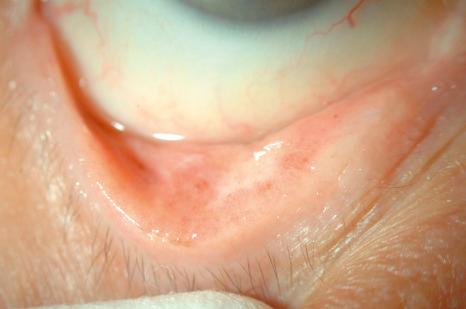
PAM without atypia is characterized by melanin pigmentation of the conjunctival epithelium with or without hyperplasia of cytologically benign melanocytes ( Fig. 27.37 ).
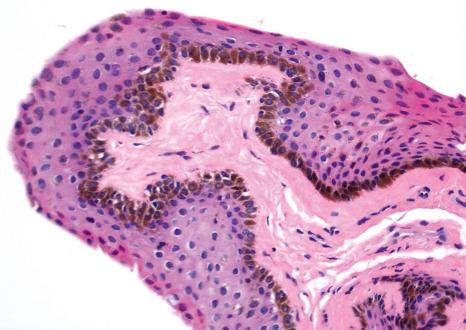
Lesions that feature cytologically atypical melanocytes are designated PAM with atypia. When evaluating the histology of PAM with atypia, the pathologist must consider both cytological and architectural features. Cytologically, atypical melanocytes have different shapes and sizes, and tend to fall apart from one another and from adjacent epithelium. Cells may be small and round, spindled, or epithelioid. Small- to medium-size cells usually have high N/C ratio, and small to medium hyperchromatic nuclei without nucleoli. Epithelioid cells have large nuclei, discernible cytoplasm, and sometimes visible nucleoli or vesicular features. Architecturally, atypical melanocytes may be distributed along the epithelial basement membrane (basilar hyperplasia pattern), segregated into nests along the epithelial basement membrane, or dispersed as intraepithelial nests or individual cells upward into the epithelium (pagetoid spread) ( Fig. 27.38 ). In some areas, atypical melanocytes may completely replace the epithelium (analogous to cutaneous melanoma in situ) ( Fig. 27.39 ).
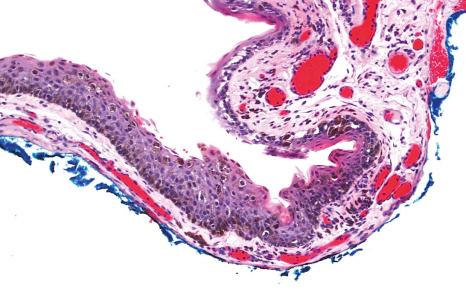
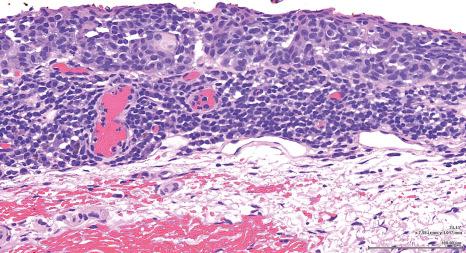
PAM with atypia is heterogeneous with variable risk of recurrence or progression to invasive melanoma. For example, Folberg et al. found that progression to melanoma was more frequent if basilar hyperplasia was not the dominant histologic pattern (90% progressed) or if epithelioid cells were present (75% progressed). Histologic scoring systems have been proposed that stratify PAM with atypia into groups with low or high risk of recurrence, invasion, and metastasis. Lesions are scored based on architectural and cytological features without or with Ki-67 immunostaining. Sugiura et al. showed that the features associated with low risk of invasion or metastasis were lesions with single cell lentiginous growth pattern, and composed of small- to medium-size cells with high nuclear-to-cytoplasmic ratio, and small to medium hyperchromatic nuclei without nucleoli. Lesions with high risk of invasion or metastasis were characterized by epithelioid tumor cells. The architectural pattern is variable, and at least focal single cell invasion of the substantia propria is frequently identified.
Potential diagnostic pitfalls include: interpretation of bulbous projection of intraepithelial nevus cells into the substantia propria, clusters of melanophages in the substantia propria, or involvement of pseudoglands of Henle by PAM as invasive melanoma; interpretation of tangential sections of basal hyperplasia or pigmentation of goblet cells as pagetoid spread; interpretation of pagetoid intraepithelial spread of sebaceous carcinoma as pagetoid spread of PAM.
Chowers and coworkers, using immunohistochemistry for Ki-67 and proliferating cell nuclear antigen (PCNA), showed that PAM with atypia has significantly higher proliferative activity than PAM without atypia. Maly et al. showed that > 1% Ki-67 staining of PAM with atypia correlated with more aggressive behavior. Use of Ki-67 immunostaining may provide helpful information about the biological behavior of PAM with atypia. Sharara and coworkers found significantly higher expression of HMB-45 in PAM with atypia than in PAM without atypia and also in conjunctival nevi. Use of HMB-45 may be helpful for pathologists to distinguish between benign and malignant conjunctival melanocytic lesions.
Become a Clinical Tree membership for Full access and enjoy Unlimited articles
If you are a member. Log in here